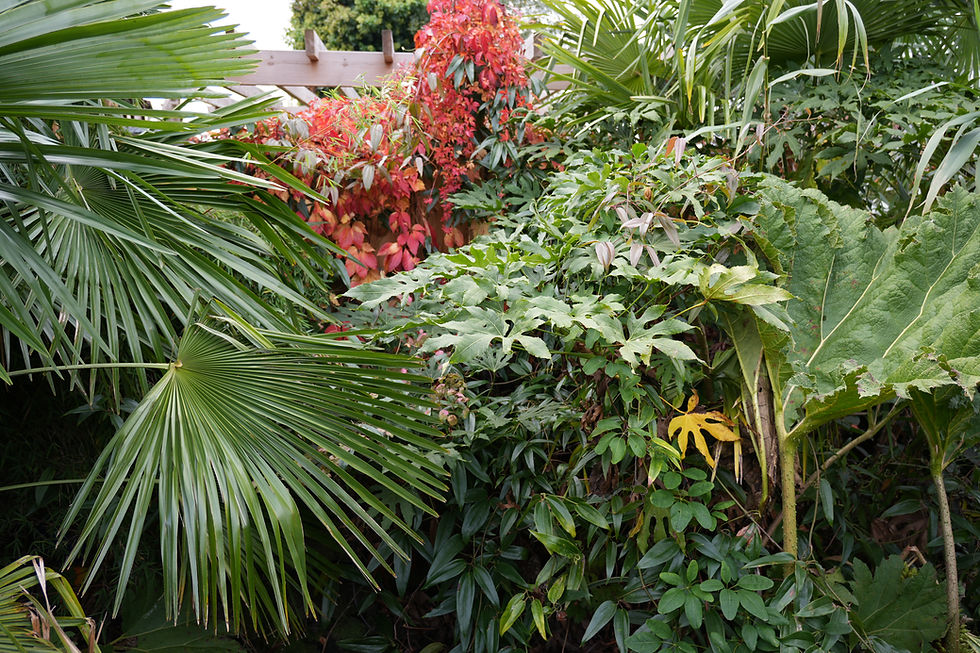🌴 How to Overwinter a Red Banana (Ensete ventricosum) – Complete UK Guide
- yorkshirekris

- Oct 20
- 4 min read
🌿 Welcome to Exotic Gardening Weekly
Hi, I’m Kris— and welcome back to Exotic Gardening Weekly!
If you’ve recently bought a red banana (Ensete ventricosum, also known as the Ethiopian or Abyssinian banana*), you’re probably wondering what to do with it once the weather turns cold. These stunning tropical plants create a bold statement in any garden, but they’re not frost-hardy, so they’ll need protection through the winter months. In this guide, we’ll go step-by-step through all your overwintering options — whether your plant is in the ground or in a pot — so you can choose the method that best suits your space and climate.

🪴 Step 1: Is Your Red Banana Planted or Potted?
The first step in deciding how to overwinter your red banana is simple:Is it planted in the ground or kept in a pot?
🌱 If It’s Planted in the Ground
Option 1 – Leave It in Place (Only for Mild Coastal or Urban Areas)
If you live in a frost-free microclimate — for example, coastal Cornwall or central London — and you’re feeling lucky, you can leave your banana outside.
It will likely die back completely, but as long as temperatures don’t drop below freezing, it should re-sprout from the base in spring.
✅ Best for: Gardeners in mild, frost-free zones⚠️ Risk: Dieback or loss in colder conditions
Option 2 – Dig It Up and Bring It Indoors
For most of the UK and Europe, leaving your banana in the ground isn’t an option. Instead, dig it up carefully before the first frost.
Now you have two main routes:
Keep it growing in a heated space
Dry-store it to keep it dormant
🌡️ Step 2: Choose the Best Overwintering Method
Option 1 – Heated Greenhouse or Conservatory
If you have a heated greenhouse or conservatory (above 10°C), you can overwinter your banana as a semi-active houseplant.
How to do it:
Dig up your banana and retain as much root as possible.
Pot it in well-draining compost.
Trim off any large leaves to save space.
Keep it above 10°C, with occasional light watering.
It’ll tick over through winter and burst into new growth in spring.
Option 2 – Dry Storage (for Large Plants)
If your banana’s base (pseudostem) is larger than 40 cm in circumference, dry-storing it is a great option.
Steps for Dry Storage:
Dig it up and remove most of the soil and roots.
Cut back the leaves, leaving only a short stem.
Let it dry for a few days in a warm, airy place.
Store it somewhere frost-free and dry — above 5°C, such as:
A loft
Spare room
Cupboard
Attached garage
Avoid detached garages or sheds, as they often drop below freezing.
The plant will stay dormant until spring. Once the weather warms, pot it up, start watering again, and it will quickly come back to life.
✅ Best for: Mature plants with thick pseudostems⚠️ Avoid: Temperatures below 5°C
Option 3 – Keep Small Plants as Houseplants
If your banana’s base is smaller than 40 cm, don’t dry-store it — it will dehydrate and struggle to regrow.
Instead:
Treat it like a tropical houseplant.
Keep it above 10–15°C indoors.
Provide bright light and occasional water.
Wipe or shower off pests such as aphids if they appear.
✅ Best for: Young or small Ensete plants⚠️ Requires: Indoor space and regular checks for pests
🪴 Step 3: Overwintering Potted Bananas
If your Ensete is still in its pot, overwintering is easier.
Option 1 – Keep Growing Indoors
For small potted plants, simply move them indoors and continue light watering through winter. Keep them in a warm, bright spot (above 10°C).
Option 2 – Keep Dormant in a Cool Space
For larger potted specimens:
Stop watering entirely.
Place them in a cool, frost-free area (5–10°C).
Light isn’t essential during dormancy.
A dark, frost-free garage, cellar, or utility room will do nicely.
✅ Best for: Large potted plants⚠️ Avoid: Detached garages or sheds that dip below freezing
🌡️ Ideal Winter Temperatures for Red Banana Storage
🌸 Summary: The Right Method for You
🌼 Final Thoughts
Overwintering a red banana might sound complicated, but it’s straightforward once you know your options. The key is to keep the plant dry and frost-free — and choose the method that fits your space.
When spring arrives, repot or replant your Ensete, start watering again, and watch it roar back into growth.
For step-by-step visual guides, visit my YouTube channel, Exotic Gardening UK, where I post weekly videos on tropical plant care, overwintering tips, and updates from my garden.
If you found this guide useful, subscribe, give it a thumbs up, and stay tuned for next week’s gardening video!





Comments